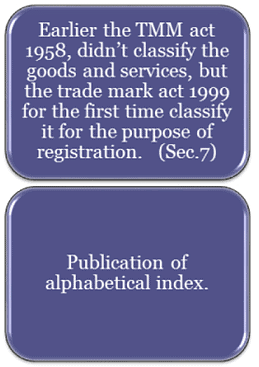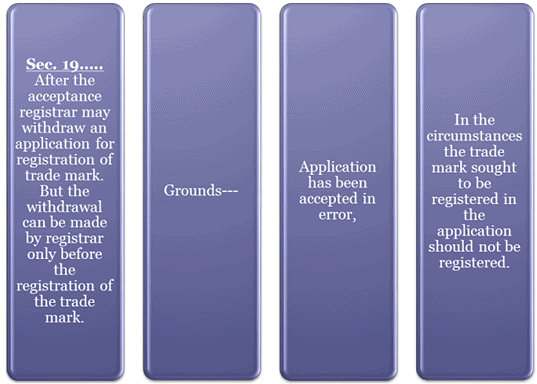Trade Mark Act, 1999 | Legal Reasoning for CLAT PDF Download

➢ The object of trade mark law is to provide for;
- The registration
- Better protection of trade marks for goods or services; and
- The prevention of the use of fraudulent marks on goods and services
➢ Development in India
- Before independence, statutory protection to the trade marks was accorded by the Trade Marks Act, 1940, which was based on Trade Marks Act 1938 of England. After that in 1953 govt, of India appointed Trade Mark Enquiry Committee to make suggestions for the reforms in 1940 act, but the member did not give any opinion. Therefore the govt appointed Mr. Justice N. Rajagopala Ayyangar of Madras High Court to examine the report of committee and make recommendations to the govt. To give effect to the recommendations made by Mr. Justice N. Rajagopala , the govt appointed Dr. Venkateswaran, officer on special duty in 1955, to draft a Trade and merchandise Marks Bill.
- Finally in 1958, the trade and merchandise marks act 1958 was passed, but again there have been considerable changes in the trading and commercial practices due to globalization of the trade and industry. To keep pace with the changing trend of investment flows and technology transfer at the international level, comprehensive amendment of TMM act, 1958, was required. So in 1999, the Trade marks bill, 1999 was introduction in the Rajya Sabha on 1st December, 1999.
By providing for the registration of the trade marks for their better protection and by preventing the use of fraudulent trade marks, the trade mark law achieve the following twin objectives:—
(i) Protection of individual interest of the proprietor of the trade mark
(ii) Protection of interest of the society
➢ Individual interest of the proprietor of trade mark
- The trade mark law protects the following individual interests of proprietor of trade mark;-
(i) Protection of exclusive right of proprietor of the trade mark over his trade mark,
(ii) Protection to assign his trade mark or any interest in the trade mark or any interest in the trade mark to the other person for a consideration,
(iii) Protection of the goodwill and reputation of the businessmen and traders
➢ Protection of the interest of the society
- Trade mark law protects the social interest of the society, social interest as the trade mark law requires a trade mark to give the following information to the purchaser;
(i) Trade mark to indicate the origin of the goods or services with which it is associated,
(ii) Trade mark to indicate the quality of the goods or services with which the trade mark is associated.
➢ Indicate the origin
- It is settled law that nobody has a right to represent his good as the goods of somebody else and sell it for his own aggrandization.
➢ Indicate the quality
- Trade mark requires a trade mark to inform the purchaser not only about the origin of the goods ad services but also about the quality of the goods or services to which it is associated.
Essential features of trade mark
According to definition (sec.2(1)(zb)) essential features are as follows
- Trade mark is a mark
- Trade mark is for goods and services
- Trade mark gives distinctiveness to goods or services
- Trade mark is used in the course of trade
Trade mark is a mark
Earlier sec. 2(1)(j)—Mark include a device, brand, heading, label, ticket, name, signature, word, letter, letter or numeral or any combination thereof. Now the trade mark act defines mark as follows Sec. 2[(1)(m)] mark include a small change which is (1) shape of goods, (2) packaging, and (3) combination of colors. A mark shall not be registered as a trade mark if it consists exclusively of-
- The shape of goods which results from the nature of the goods themselves; or
- The shape of goods which is necessary to obtain a technical results; or
- The shape which gives substantial value to the goods.
Trade mark gives distinctiveness to the goods or services
Distinctiveness is the essential feature of the trade mark. Distinctive character means a characteristic of goods or services which is capable of distinguishing the goods or services of one person from those of another person. If it is deceptively similar to another trade mark and therefore is deviod of distinctive character, a trade mark is refused registration under the trade mark law.
Trade mark is used in the course of trade or business
A trade mark is a mark used or proposed to be used in relation to goods for the purpose of indicating or so as to indicate a connection in the course of trade between the goods and some person having the right to use the mark.
A proprietor of trade mark may apply for the registration of the trade mark if:
- He has been using that trade mark;or
- Is proposing to use that trade mark in the course of business or trade
On the ground of non-use, a registered trade mark may be struck off the register of trade marks maintained under the trade mark law.
Authority of the Registrar of trade marks
- Sec. 3 “registrar of trade mark”- The controller general of the patents, designs and trade marks appointed by the central government, by notification in the official Gazette, is the registrar of the trade mark. The central government may also appoint such other officers with such designations as it may think fit under sec. 3 for the purpose of the act. These officers discharge the functions of the registrar as they may be authorised by the registrar under his supervision.
- Powers of registrar
(i) Power to withdraw or transfer cases (sec.4)
(ii) Power to vary or cancel registration relating as registered user (sec.50)
(iii) Power to call for information relating to agreement in respect of registered users (sec.51)
(iv) Alteration of registered trade mark (sec.59)
(v) Power of civil court (sec.127)
(vi) Exercise of discretionary power (sec.128)
(vii) Evidence before registrar (sec.129)
(viii) Extension of time (sec.130)
- Office of the trade mark registry: Sec.5 Office has been established for the registration of trade mark. As central govt, may think fit, the Head office and the branch offices of the trade mark registry are established at some places, according to territorial limits(branch office). The branch offices have been established at Delhi, Calcutta, Madras and Ahmadabad. The head office was earlier in Bombay which now has been shifted to Delhi. The office has its own seal.
- Rectification and correction of the register of trade mark: Sec 57 to 60 provide provisions regarding rectification and correction of the register of the trade mark as follows;-
(i) Rectification on the application of the aggrieved person (sec. 57)
(ii) Correction on the app. Of the registered proprietor (sec 58)
(iii) Alteration of registered trade marks (sec.59)
(iv) Adaptation of entries in register to amended of substituted classification of goods or services (sec.60)
➢ Condition for the registration of trade mark
 ➢ Grounds for the refusal for registration for certain trade mark under act 1999.
➢ Grounds for the refusal for registration for certain trade mark under act 1999.

➢ Act divides the grounds for refusal for the registration as follows:
- Absolute grounds for refusal(sec.9)
- Relative grounds for refusal(sec.11)

➢ Ordinary trade mark
- Sec.11(1) a trade mark is refused registration for goods or services if it is similar to an earlier trade marks associated with similar goods or services if the earlier trade mark is an ordinary trade mark.
➢ Well known TM
- Sec. 11(2) a trade mark is refused to registration for goods and service if it is similar to an earlier trade mark even if associated with different goods or services if the earlier trade mark is a well known TM.
➢ Protection of well known trade mark
- Case law. Bata India Limited v. M/s. Pyarelal & Co, AIR 1985 All 242
Procedure for registration of trade mark
Sec 18 to 23 of the ac deals with this. Following is the procedure;
(i) Acceptance of application for registration (sec. 18)
(ii) Withdrawal of acceptance (sec. 19)
(iii) Advertisement of accepted application (sec. 20)
(iv) Opposition to registration (sec. 21)
(v) Correction and amendment of application (sec. 22)
(vi) Registration (sec. 23)
(i) Sec. 18 : The application for the registration of the trade mark is made by proprietor of the trade mark to the Registrar in writing and filed in office of the trade marks registry. The registrar may, refuse the application, accept it or accept it subject to such amendments, modifications, conditions or limitations, if any , as he may think fit. in case of refusal registrar have to write the ground of the refusal in the record.
(ii) Sec. 19

(iii) Sec. 20 : After accepting the application whether absolutely or conditionally , the registrar advertise the application in the prescribed manner, so that if any person has nay objection, he may give notice to the registrar. After the advertisement application may be corrected or amended by the registrar.
(iv) Sec. 21 : Opposition to registration
- Notice of opposition by any person.
- Counter statement by applicant. (2 months)
- Notice of counter statement to the opponent.
- Registrar to hear the applicant and opponent.
(v) Sec. 22 : Application may be corrected or amended by the registrar at any time.
(vi) Sec. 23 : The registrar register the TM if after the acceptance of the application , the application:
- Has not been opposed,
- If opposed decided in the favour of applicant.
After the registration, registrar issues the applicant a certificate of registration of TM, which is sealed with the seal of the trade mark registry.
➢ Effect of registration of trade mark
- The registration of the trade mark law is not compulsory. The trade mark exists independently of the registration. It is well established that a person can become proprietor of the TM either by virtue of its use or by its registration.
➢ Case law - In Hidesign v. Hidesign
- Creations,1992 IPLR 69, the trade name of the plaintiff was not registered. The defendant used the unregistered trade name of the plaintiff for his goods. In this case, as the trade name of the plaintiff is not registered, but the plaintiff did restrain the defendant from the use of the unregistered trade name of the plaintiff by seeking the remedy of passing off under the trade mark law.
Benefits of registration
Though registration of trade mark is not compulsory under the TM law but the registration is beneficial to the proprietor of the trade mark, because TM law confers following benefits —
- Institution of any proceeding to prevent, or to recover damages for the infringement of the registered TM(sec 27)
- Exclusive right to use the registered trade mark (sec 28)
- Prima facie evidence of the validity of TM(sec31)
- Registration of trade mark to be conclusive after 7 year from the date of registration
Infringement of trade mark
- Sec..29(1) A registered trade mark is deemed to be infringed by a person who neither being the registered proprietor nor permitted user of the registered trade mark uses a trade mark which is identical with or deceptively similar to the registered trade mark.
- Circumstances in which a person is deemed to infringe a registered trade mark under the trade mark act, 1999.
(i) A person is deemed to infringe a reg.TM if not being a “registered proprietor” use a trade mark which create confusion to the public and similar to the registered trade mark.
(ii) Which is identical to the registered TM used in course of trade for the goods or services which are not similar, TM has already reputation in India,
(iii) TM is infringed by the person who is not being authorised to use by the proprietor, use TM for labelling or packaging goods, Or as a business paper, for advertising goods or services.
(iv) TM is infringed by a person if he uses such registered trade mark, as his trade name or part of his trade name, as name of his business concern or part of the name, of his business concern dealing in goods or services in respect of which the trade mark is registered.
(v) A registered TM is infringed by any advertising of that trade mark if such advertising, takes unfair advantage of industrial matters, is distinctive character, is against the reputation of the trade mark.
(vi) Where the distinctive elements of a registered TM consists of or includes words, the trade mark may be infringed, the spoken use of those words, as well as, the visual representation of those words.
Deceptively similar sec.2(1(h)), A trade mark is deceptively similar to another mark if it so nearly resembles that other mark as to be likely to deceive or cause confusion.
➢ Case laws
- In Horlicks Limited & others v. Kartick Sadhukar, 2002 (25) PTC 126 (Del). The plaintiff, horlicks ltd, is the proprietor of the trade mark “HORLICKS” which was registered in India for the products like energy boosting food products, including foods for infants, malted milk, biscuits, toffees, etc. The defendant trading as kartick confectionary, started manufacturing toffees under the trade mark HORLICKS . In this case, the defendant was restrained from using the trade mark, HORLICKS of the plaintiff, as it infringed the trade mark HORLICKS of the plaintiff.
When certain acts do not constitute infringement
Sec 30 limit on effect of registered trade marks,
- Is in honest practices in industrial matter,
- Is not such as to take unfair advantage,
- Registered TM is not infringed where—
- The use in relation to goods or services indicate the kind, quality, of goods,
- A trade mark is registered subject to any conditions or limitations, the use of the trade mark in any manner in relation to goods to be sold or otherwise traded in, in any place, to which having regard to those conditions, the registration does not extend,
➢ Passing off of registered and unregistered trademarks
- Today trade law provides for the registration for the trade mark for better protection of registered and unregistered TM , as the registered proprietor has the right to institute legal proceedings for the infringement of his reg.TM. But before this law came into force, the proprietors of unregistered TM protected their TM under the common law of TORT (remedy for passing off)
- Passing off (action against a person who passes off his goods as the goods of another for the civil offence of “deceit”) It is depends upon the principle that nobody has any right to represent his goods as the goods of somebody else.
➢ Case law
- Jolen Inc v. Doctor & company ..2002 (24)PTC 29(del)
Earlier to protect the unreg. TM, sub.sec. (2) of sec.27 of the TMM Act, 1958, provide for an action for passing-off. Now similar provision for passing off has also been made under sec.27(2) of Trade mark act 1999.
➢ Difference between infringement and passing off
- Remedy of infringement only for registered TM. Passing-off for reg. as well as for unreg. Also
- Infringement provide under TM act only, whereas the remedy of passing off is provided under the TM act and under common law also.
- In an action for infringement of a trade mark, title of plaintiff is established by the evidence of valid registration. In passing-off title is established by the evidence of reputation and goodwill of the business acquired by the use mark.
➢ Court for suit (infringement & passing-off)
- Court which is not inferior to a District Court having jurisdiction to try the suit. Provided under section 134, 105 of TM act 1999.
Assignment, Transmission
- Section 37 to sec 45 deals with the assignment and transmission of the trade mark.
- Proprietor may assign TM itself to another person with or without the goodwill of the business.
- It may be transmitted also to another person by the operation of law.
Section 2[1(a)] Assignment means an assignment in writing by act of the parties Section 2[1(zc)] transmission means transmission by the operation of law, devolution on the personal representative of a deceased person and any other mode of transfer, not being assignment.
- • Assignment by registered proprietor only. (37)
- Effectual receipt for any consideration.(Reg. proprietor)
- Tm may be assigned or transmitted with or without the goodwill of the business concerned.(38)
- Like a reg. TM unregistered TM may also be assigned or transferred with or without the goodwill of the business concerned without any consideration.(39)
- Sec. 40 trade mark cannot be assigned or transmitted in favour of two or more persons, because it is likely to cause confusion and to deceive, (restriction)
- Sec.43 assignability and transmissibility of certification trade mark.( with the consent of central government)
Licence of Trade mark
- Section 48 to 56 of trade mark act 1999, provide for the permitted use of the trade marks by the registered user of the trade mark.
- Permitted use means by a registered user.
- Registered user (48) a registered user may be registered to use the registered trade mark in respect of any or all of the goods or services in respect of which the trade mark is registered.
- Registered user [2(1)(x)] means a person who is for the time being registered as such under section 49.
- Cancellation of registered user (sec.50) : The registration of registered user may be varied or cancelled by the registrar on the application of
(i) Registered proprietor, or
(ii) The registered user,
(iii) Any other registered user of the trade mark
The registrar may also cancel on its own motion or on the application of any person if any stipulation in the agreement between the registered proprietor and registered user regarding the quality of goods in relation to which trade mark is to be used:—
(i) Is not enforced, or
(ii) Is not being complied with
- Sec.54 registered user not to have right of assignment or transmission
The document Trade Mark Act, 1999 | Legal Reasoning for CLAT is a part of the CLAT Course Legal Reasoning for CLAT.



 ➢ Grounds for the refusal for registration for certain trade mark under act 1999.
➢ Grounds for the refusal for registration for certain trade mark under act 1999.

